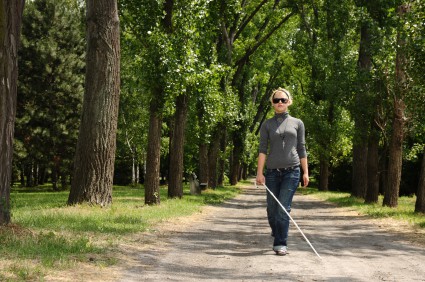New study investigates neural basis of human echolocation.
You probably know that bats and dolphins use echolocation to navigate, but did you know that some blind people use it to mountain bike, play soccer, or navigate cities? They make clicking sounds with their tongues and listen to the returning echoes to sense information about the position, size, shape and texture of objects.
A new study, the first in its field, found that blind echolocators process the clicks and echoes by using brain areas that sighted people use to process visual information. Published recently in the scientific journal PLoS ONE, the study examined brain activity in two expert blind echolocators using functional magnetic resonance imaging scans (fMRI). The Early Blind and Late Blind subjects lost their sight at 13 months of age and 14 years of age respectively. Two non-echolocating sighted subjects were also evaluated for control purposes, matched with the test subjects by sex and age.
The study design required a creative approach to measure brain activity, given that a test subject needs to be completely still to produce a good fMRI scan. To address this, researchers made sound recordings of the subjects’ own clicking noises and played them back while using an fMRI scanner to detect BOLD, or blood-oxygen-level dependent activity.
Surprisingly, when the echolocators listened to test sounds that contained clicks and echoes, compared to test sounds that contained only clicks, researchers measured activity in the subjects’ visual cortex areas known as the calcarine, but not the auditory areas. Lead author Lore Thaler, postdoctoral fellow at The Centre for Brain and Mind at Western University in London, Ontario says, “This was exciting for us! With this comparison, we saw differences in the visual parts of the brain without differences in the auditory. I expected to see brain activity in both the auditory and the visual cortex of the brain.”
Both the Early Blind and Late Blind test subjects showed brain activity in their middle temporal and nearby brain areas when they were listening to sound recordings of moving objects. Those are the brain areas that activate when sighted people view an object in motion. The Early Blind test subject showed more proficiency in distinguishing the angular position of a pole compared to the Late Blind tester, but both were excellent.
Daniel Kish was the Early Blind test subject in Thaler’s study. He is able to mountain bike, navigate in the wilderness alone and can sense a building 1,000 feet away. He founded World Access for the Blind, a non-profit organization with a mission to help blind people learn echolocation so that they can participate and achieve at the same level as sighted people. Daniel and his colleagues have worked directly with over 500 blind students to teach them how to use echolocation.
The World Health Organization estimates that there are 39 million people worldwide who are blind. In the United States alone, there are 937,000 adults over the age of 40 who are blind. Kish says that there are no hard statistics available about how many blind people are using echolocation, but from his experience, “about 50% of blind people may use some form of echolocation to help them interact with the environment.” He continues, “this is usually rudimentary, and they are usually unaware of what they are doing, or how. Perhaps around 5% actually develop an advanced form of echolocation whereby they typically use some form of self-generated sonar signal.”
Thaler says that echolocation can be a useful tool for sighted people, to sense objects in the dark or behind them. She is trying to learn the technique herself, and can sense the difference in objects placed in front of her while blindfolded. She admits that she needs to find an uninterrupted stretch of time to refine her learning.
The basic skills of echolocation can be learned in 2-3 days and refinement takes place over time for each individual. Kish says, “It is a skill much like any other. It definitely takes practice for refinement, and inherent talent does help, but is not required. It is easiest for young ones to learn, but older folks can also learn if they are motivated. Our motto is “the earlier the easier, but it’s never too late.”
Since the study was published, Thaler has received many emails from blind people who have never heard about echolocation before. She hopes that future studies will continue to unravel the mysteries of how echolocation works so that more can learn to live their lives with no limits.
CONNECT THE DOTS
Visit the site for World Access for the Blind to learn more about the organization, including training, workshops, services and advocacy efforts to help blind people live their lives with No Limits. Watch World Access for the Blind’s You Tube channel to hear Daniel Kish and his associate Brian Bushway discuss and demonstrate echolocation.


